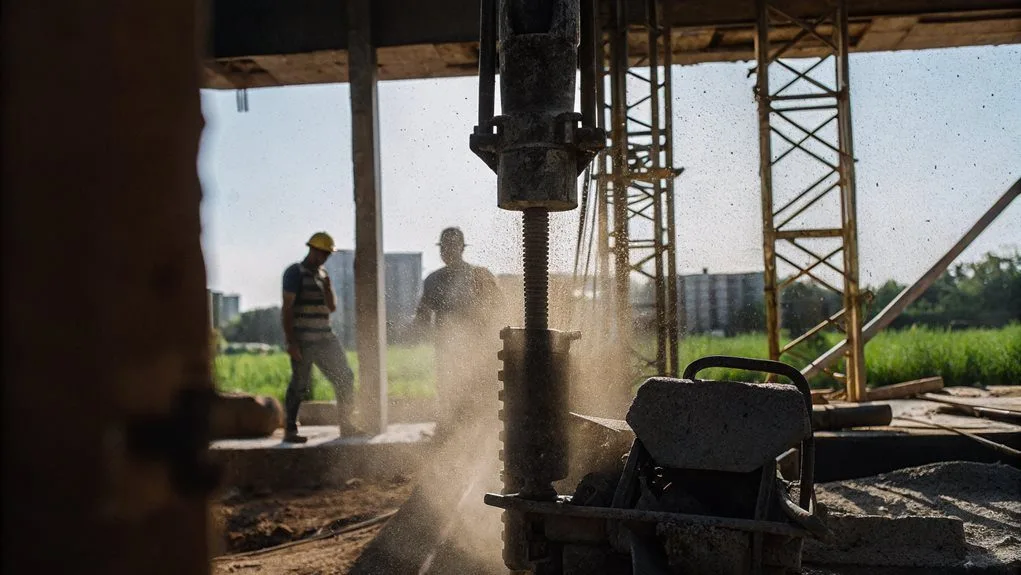So, you’re stuck deciding between dry hire and wet hire? With dry hire, you’re the captain—no operator included, just you, the gear, and a hint of risk. Wet hire? You get a certified operator to handle the tricky bits—like a personal chef versus microwave meals.
Sure, dry hire seems cheaper, but don’t forget those sneaky extra costs! If you think that’s it, stick around, because there’s more to this plant hire conundrum than meets the eye.
Key Takeaways
- Dry hire involves renting equipment without an operator, requiring users to manage operation and maintenance themselves, which can save costs.
- Wet hire includes equipment along with a certified operator, offering convenience and specialized skills for efficient project execution.
- Dry hire can lead to hidden expenses such as fuel, insurance, and maintenance costs, while wet hire generally costs 30-40% more upfront.
- Users benefit from reduced operational burdens and safety compliance with wet hire, as trained professionals handle complex tasks on-site.
- Both hire options create different budgeting approaches, with dry hire allowing clearer separation of equipment and labour costs for more accurate financial planning.
Understanding Dry Hire: The Basics
So, you’ve heard about dry hire, have you? It’s basically renting equipment, like excavators or bobcat loaders, without an operator. Sounds brilliant, right?
But here’s the catch: you’re responsible for running and maintaining the kit. Yeah, that’s right! No operator included. If you can’t operate heavy machinery, you might want to rethink this.
You’re in charge of operating and maintaining the gear—no operator here! Not ready? You might want to reconsider.
On the bright side, dry hire usually saves you rands since you’re not paying for labour. Plus, it ensures that the equipment is fully compliant with safety specifications. However, you should also note that dry hire requires self-operation and can pose risks if you’re not skilled.
But don’t get too comfortable; you’ll need to fill the tank and stay on top of maintenance.
Got experience? Brilliant! If not, well… maybe it’s time to brush up on those skills.
Just remember, using the equipment safely isn’t a suggestion—it’s a must!
Exploring Wet Hire: Key Features
Ever wonder why so many folks are jumping on the wet hire bandwagon? Let’s break it down.
When you go wet, you’re not just hiring equipment; you’re getting a certified operator—no more flying solo like a hero in a low-budget action film. Plus, maintenance is included—goodbye worries about breakdowns. It’s like having your cake and eating it too, right? Additionally, the wet hire arrangement can combine equipment and personnel in one seamless deal, making it more convenient for project management. The best part? You can tap into specialized operator skills that ensure the machinery is handled with expertise.
But wait, there’s more.
You might score services like fuelling and insurance, too—who knew equipment hire could feel like a spa day?
This all leads to better safety and efficiency on-site, meaning you can finally finish that project on time without pulling your hair out.
Cost Analysis: Dry vs. Wet Hire
Regarding choosing between dry and wet hire, you’re in for a wild ride of costs.
You might think dry hire is cheaper, but don’t forget about those sneaky hidden expenses like insurance and maintenance. Additionally, dry hire enables accurate budgeting by itemizing equipment costs separately from labor and overhead, which can help clarify your financial commitments. Choosing dry hire may be more cost-effective if your business has skilled personnel to operate the equipment efficiently.
On the flip side, wet hire sounds all-inclusive, but you’re definitely paying for that operator skill—and it can really add up, can’t it?
Cost Breakdown Comparison
Comparing costs between dry hire and wet hire is like choosing between a fast-food burger and a gourmet meal—you know one’s cheaper, but do you really want to skimp on quality?
Dry hire usually saves you rands, but don’t forget, you’ve got to manage the maintenance and also find your own operators. Isn’t that fun? In cases of dry hire, only the equipment is provided, which means all responsibilities fall to you.
Wet hire may cost 30-40% more, but it provides a handy operator and insurance, along with access to experienced certified operators. Sounds easy, right?
You’ll pay a premium for that convenience, but who wouldn’t want to avoid the hassle of breakdowns?
Sure, you get control with dry hire, but when headaches hit, wouldn’t you rather let someone else deal with the mess?
Makes you think, hey?
Long-Term Financial Implications
You thought you’d it all sorted with dry and wet hire, right?
But what about those long-term financial implications?
Predictable expenses are brilliant—no one fancies surprise bills.
Renting means no depreciation costs; that’s the rental company’s problem, not yours.
Plus, they’ve got maintenance covered!
You can breathe easy knowing you won’t be struggling to keep track of equipment upkeep.
And hey, cash flow management?
It’s like magic when you know what to expect.
Think you can just adjust your fleet size without breaking the bank?
You certainly can!
Also, enjoy the latest equipment without the hefty price tag.
Still, it’s wise to chat with your accountant about potential tax benefits.
Just remember, you’re not the one buying the headache.
Operational Control and Scheduling
How on earth do you keep track of all the moving parts in plant hire?
Seriously, if you’re not using centralised systems, good luck!
With the right plant hire software, you can manage equipment and resources all in one place.
Think asset tracking for locating gear—no more searching high and low!
Scheduling tools? They’re your new best friend in matching the right operators with jobs.
Calendar views let you spot conflicts faster than your coffee breaks.
And let’s not forget about keeping operators’ licences in check.
Preventing double bookings isn’t just a fantasy; it’s possible!
Sure, it sounds complicated, but with the right tools, you can run this show like a pro. No sweat… right?
Skills Development Opportunities
So, you think you can just operate heavy machinery without some solid skills?
Practical experience isn’t just a nice-to-have; it’s your ticket to enhancing workforce competence and keeping your job.
Plus, with all those continuous learning opportunities out there, you might finally stop feeling like a deer caught in headlights every time a new tech pops up!
Practical Experience Gain
Why is it that everyone seems to think you can just waltz into a plant operations job without any skills?
It’s not like you can wish your way into the role with a sprinkle of magic.
Sure, you might get lucky and find a job, but without practical experience, good luck thriving.
Most power plant operators spend years gaining on-the-job training.
Plus, that whole skills gap thing? Yeah, it’s a real hurdle.
You need to know how to operate monitoring systems and analyse performance data, not just look good in a hard hat.
And let’s be honest, who really wants to be that person fumbling around?
You’ll want some proper training under your belt if you’re serious about sticking around in the South African energy sector.
Enhanced Workforce Competence
Ever wonder why some folks just seem to breeze through plant operations whilst others struggle to keep up? It’s not just luck, my friend. That “effortless” crew likely invested in training programmes customised for today’s demands.
Companies are tapping funds like the Skills Development Levy through SETAs to enhance your skills without breaking the bank.
And let’s face it, with AI guiding job seekers towards in-demand skills, sticking your head in the sand’s not an option.
Plus, 70% of business leaders swear by tackling those skills gaps to spark innovation.
But here’s the kicker: nearly half of you looking for training can’t even get the resources!
Continuous Learning Opportunities
Finding the right training opportunities can feel like digging for buried treasure, can’t it?
You’ve got options like CPA Skills & Training, offering the essentials for plant hire.
Sure, there’s manufacturing training that sounds useful, but let’s be honest—how do those troubleshooting skills really help you on the plant site?
Then there are pre-apprenticeships. Great, but do you have time for that before jumping in?
Look, we’ve got skills shortages, and partnerships between education and industry seek to solve that.
You want operational skills and safety training, but do you really trust those outdated methods?
Here’s the kicker: you might just need a bit of excitement to find that perfect blend of training that helps you thrive. Good luck out there!
Making the Right Choice for Your Project
Making the Right Choice for Your Project
So, how do you decide whether to hire equipment with or without an operator for your project? It’s like choosing between a ready-made meal and cooking from scratch—both have advantages, but your kitchen skills matter.
If you’ve got a skilled crew, dry hire could save you some rand.
But if you’re tackling something complex, wet hire brings trained professionals into the mix.
Think of it this way: hiring a bulldozer with an operator is like hiring a personal chef, whilst dry hire is more like a fancy microwave.
Hiring a bulldozer with an operator is like opting for a personal chef, while dry hire is akin to using a fancy microwave.
And hey, let’s not forget all those sneaky extra costs like fuel and delivery.
In the end, your choice should match your project’s needs—and your budget.
Conclusion
So, whether you go for dry hire or wet hire, it really depends on your project. Want full control? Go dry. Need a helping hand? Wet hire’s your buddy. Just remember: every choice brings its baggage. You can’t expect a shiny new toy without some strings attached, right? It’s like picking between pizza or tacos—both have their perks and pitfalls. So you’ve got to weigh your options wisely, because nobody wants a rental nightmare.






